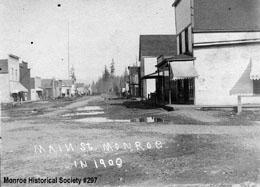On September 86, 1901, an arsonist sets fire to the Odd Fellows Hall in Monroe. Soon adjoining buildings are in flames on the town’s Main Street. A fire alarm rouses an audience of citizens. In a short time the fire reaches Monck’s hardware store, Welborn’s Furniture Store, a barbershop, a bath house and residence, a drug store, the Royal Restaurant and W. R. Pearsall’s tobacco and confectionery store. All are destroyed. Many owners are uninsured.
Arsonist to Blame
It was believed that it was an arsonist who came to Monroe in mid-September 1901 and set the fire that burned the town's principal block to ashes. The fire devastated the south side of East Main Street. At 1:10 on that Wednesday morning, Dr. Robert Ball, returning from a professional trip to Wallace, discovered the large two-story Odd Fellows hall ablaze in the upper story. The alarm brought the entire town to the scene.
Nate Brady entered the hall first with the thought to save the records of the different fraternal orders who met there. He rushed upstairs and pushed against the anteroom door, which collapsed. A dense smoke almost overcame him, and he only escaped by rolling back down the stairs and out. The anteroom contained no fire and the smoke was cool as if it came from above. The fire at that time had not reached below the first floor. That changed rapidly.
Saving the Contents
Everybody started to carry out the contents of the business houses. B. L. Monck’s hardware store, next to the hall on the east, had about 15 minutes for willing workers to remove a good part of the contents. Monck, uninsured, lost his shelf goods and the contents of his warehouse. T. F. Welborn’s furniture store was next, but the stock had been completely removed by the time the fire got to it. John Brady owned the buildings housing these two stores and he was partly insured.
The Henry Dennis barbershop, bath house, and residence was next and it was thought the fire had been checked because an intervening space of 10 feet allowed use of the water from a small hose. But the fire swept under the house and it was soon ablaze. Dennis had no insurance. He dashed out to the shed behind the barbershop, hitched up his pacing horse to the buggy, and raced with his family out to the Tualco Valley to escape the fire.
The fire raced through E. A. Roberts’ drug store and moved to G. W. Mack’s large two-story building that included the Royal Restaurant and W. R. Pearsall’s tobacco and confectionery store. All these stores by now were devoid of contents, and were roaring masses of flames.
Wind Changes Direction
On the other side of the Odd Fellows hall to the west, a space of 50 feet separated it from H. M. Treadwell’s one-story building, and the fire workers thought it to be out of danger with the aid of the water system. A light change in the wind as the large hall fell in, however, drove the flames against the sides of the building, and it caught from end to end. No effort had been made to remove the contents, and very little of the household effects were saved.
The corrugated iron warehouse of J. E. Dolloff and Company gave hope of withstanding the conflagration, and until the roof of the adjoining two-story main store building ignited, no effort was made to carry out the contents. At this point, Dolloff threw open the doors to the willing helpers, and they went in with a rush. They removed the Monroe Post Office without loss. About half of the general merchandise was carried out but flames soon drove everyone out of the store. The fire allowed the helpers about 15 minutes before they had to abandon their efforts. The household goods in back and in the upper story were mostly removed.
Fire and Intense Heat
Both ends of the block were burning furiously by then and the heat intense. For a few minutes, people panicked with the thought the buildings across the street might burn. The structures smoked and sizzled with the heat, and the windows popped and fell onto the sidewalk. It was only the greatest heroism that prevented the flames from crossing over and taking out the north side of East Main Street, too.
Firefighters had little hope of saving J. A. Vanasdlen’s two-story building across Ferry Street from the fire and it blazed at one time. Most of the contents had been removed. Luckily, the intense heat lasted just minutes and the fire danger passed.
Rebuilding Monroe
All the fraternal orders that met in the IOOF Hall lost their records and paraphernalia. They decided to rebuild but where and on what plans would be decided later.
Dolloff vowed to rebuild at once. He said as soon as the insurance was adjusted, he’d take a trip to Seattle to get plans. He received telegrams from all over the country extending whatever aid his friends could give. The new Dolloff building still sits on the southeast corner of Main and Lewis streets.
John Brady went up to Stephens Brothers Mill immediately after breakfast on the day of the fire and ordered lumber to rebuild. Both Monck and Welborn occupied their old locations. Dennis opened his barber business in the Elliott block while he rebuilt his shop.
Druggist W. A. Roberts found a temporary location at Vanasdlen’s store while he cleared his site for a new building. W. R. and H. E Pearsall purchased Mack’s corner lot and rebuilt immediately. In the meantime, they established their tobacco and confectionery business in Vanasdlen’s implement warehouse.
Dolloff’s advertisement on the front page of the same Monroe Monitor that reported the fire said, “We have been put out of business temporarily, but will resume shortly on a more extensive scale than before. Long live Monroe!”

